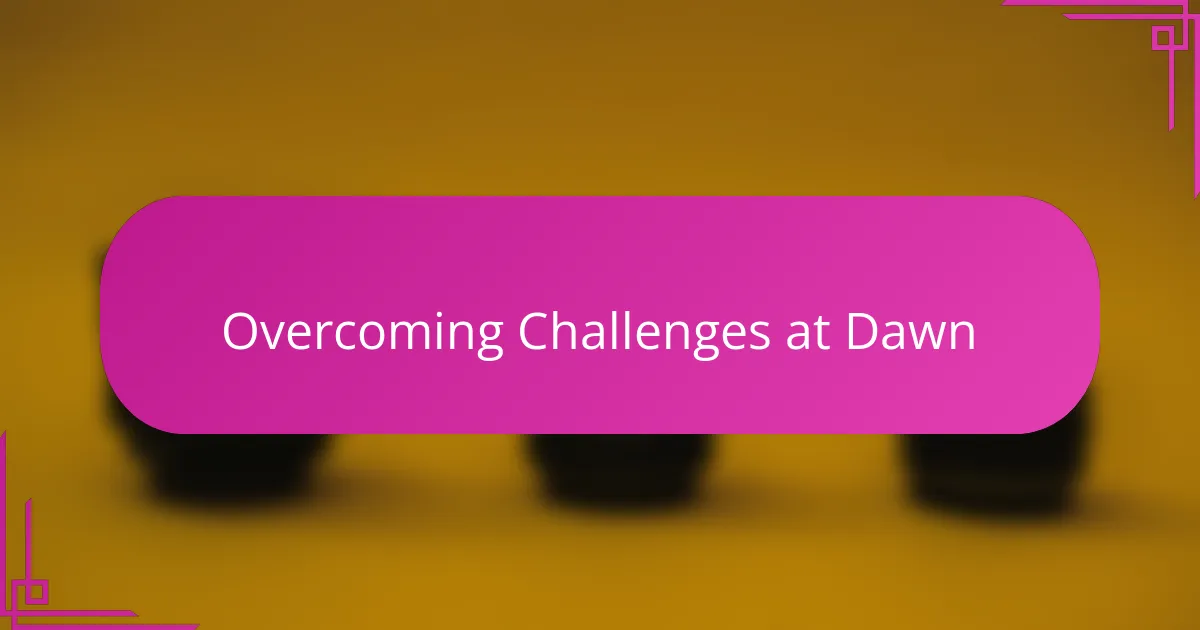Key takeaways
- Patience and timing are crucial for dawn photography, allowing for the capture of unique light and colors.
- Essential gear includes a sturdy tripod, remote shutter release, wide-angle and zoom lenses, plus extra batteries and memory cards.
- Preparation and planning, such as arriving early and choosing the right rim, enhance the shooting experience and outcome.
- Experimenting with composition, settings, and creative instincts can lead to stunning and unique photographs of the Grand Canyon at dawn.

Understanding Dawn Photography Techniques
Dawn photography is all about patience and timing. I remember setting my alarm before the first light broke, feeling the thrill of capturing colors that unfold gradually. Have you ever noticed how the soft, cool tones at dawn create a calm mood that’s impossible to replicate later in the day?
One technique I rely on is using a slow shutter speed to catch the subtle gradient of the sky. It allows you to bring out delicate details and avoid harsh contrasts that midday sun can cause. Isn’t it fascinating how this early light gently sculpts the landscape?
Understanding light direction is another key. At dawn, the sun rises slowly, casting long shadows that add depth to your composition. I’ve found that positioning myself with the sun at a slight angle gives the Grand Canyon an almost magical dimensionality, making every shot feel like a new discovery.

Essential Gear for Dawn Shoots
Having the right gear is a game-changer when shooting at dawn. I always bring a sturdy tripod because the low light means longer exposures, and even the slightest movement can blur those precious moments. Don’t you hate it when you get the perfect scene but end up with a shaky photo?
A remote shutter release is another must-have for me—it helps avoid any camera shake and lets me stay fully present, soaking in the unfolding light rather than fiddling with buttons. Also, my lens choice matters a lot; a wide-angle lens captures the grandeur of the canyon, but a zoom lens lets me highlight intimate textures and patterns that dawn light reveals so beautifully.
Lastly, I never forget extra batteries and memory cards. Cold temperatures at dawn can drain power quickly, and I’ve lost shots once because of that. Have you ever been mid-shoot and realized you’re out of space or juice? It’s frustrating, and these small precautions make all the difference between a missed moment and a perfect sunrise capture.

Planning Your Grand Canyon Visit
Planning a visit to the Grand Canyon for a dawn shoot means thinking ahead about timing and location. I learned early on that arriving well before first light is crucial—not only to set up my gear but also to choose the perfect spot before the crowd shows up. Have you ever raced against the clock to catch that fleeting golden hour? It’s a mix of excitement and nerves that pushes you to be ready in every way.
Choosing which rim to shoot from also made a big difference in my experience. The South Rim offers those classic sweeping vistas, while the North Rim felt more intimate and less busy when I went. I found that scouting these areas through photos online only takes you so far; actually being there at dawn reveals surprises you don’t expect, like hidden shadows or unexpected colors.
Lastly, consider your pace and comfort—carrying heavy gear uphill before dawn is no joke. I usually pack layers and snacks because the chill can sneak up on you, and hunger can dampen your focus just when the light is turning magical. Do you plan for these small comforts? Trust me, they help keep your energy up and your mind sharp for those incredible first shots.

Settings for Capturing Sunrise Colors
Capturing those vibrant sunrise colors means dialing in your camera settings to embrace the low light without losing detail. I usually start by setting a low ISO, around 100 or 200, to keep noise to a minimum, but I balance that with a slower shutter speed to let in enough light—sometimes I let it stretch to a few seconds, relying on the tripod to keep things steady. Have you ever noticed how a bit of underexposure can actually intensify those pinks and oranges, making the colors pop even more?
Aperture plays its part too. For me, shooting between f/8 and f/11 strikes the perfect balance—sharp enough to capture the canyon’s textures while maintaining a pleasing depth of field. It’s amazing how a slightly smaller aperture helps keep both the foreground and the distant cliffs in crisp focus, adding layers to the image. I remember missing that detail once—I was too wide open, and some magic was lost in the blur.
White balance settings can truly influence your mood. I tend to set it to “Cloudy” or “Shade” to warm up the cool dawn tones naturally, giving the scene that rich, golden glow that feels almost tangible. Have you played around with this before? Tweaking white balance in-camera saves time in editing, and sometimes those subtle warmth shifts bring the canyon’s awakening to life like nothing else.

Composing the Perfect Grand Canyon Shot
Finding the perfect composition in the Grand Canyon at dawn means more than just pointing and shooting. I often look for natural leading lines—like the winding river or layered rock formations—that draw the eye deep into the frame. Have you ever noticed how these lines create a journey for your viewer, inviting them to explore the vastness right alongside you?
Balancing the vastness of the canyon with interesting foreground elements has always been a challenge and a joy for me. Sometimes, a lone tree or a cluster of vibrant wildflowers becomes the anchor that grounds the enormity of the scene. It’s amazing how a small detail can transform a sprawling vista into a story that feels intimate and alive.
Framing is everything when you’re dealing with such overwhelming scale. I experiment with different angles—sometimes crouching low to emphasize textures, other times finding high ground to capture the canyon’s layers stacked like a natural cathedral. Have you played with perspective in your shots? It’s those shifts that turn a good photo into one that truly captures the spirit of dawn at the Grand Canyon.

Overcoming Challenges at Dawn
Dawn shoots come with their fair share of hurdles—I remember one morning when the cold seeped right through my layers, making my fingers numb just as I was trying to adjust my lens. Have you ever struggled with fumbling gear in the dark? It’s frustrating, but layering up and preparing for the chill really made a difference in staying focused.
Another challenge is the fleeting light itself; dawn waits for no one. I’ve often felt the pressure as colors shift and shadows retreat in seconds, pushing me to react quickly without losing composure. How do you stay calm when time is racing against your perfect shot? For me, it’s about trusting my preparation and muscle memory—it’s the only way to keep pace with the dawn’s changing mood.
Early morning conditions can also test your patience—fog rolling in unexpectedly or wildlife wandering too close—but overcoming these surprises often leads to the most authentic and memorable captures. I’ve learned that flexibility is key; sometimes the scene you hadn’t planned for becomes the one you cherish most. Have you had those moments where a setback turns into something magical? It’s those experiences that make dawn photography so rewarding.

Final Tips for Stunning Photos
One final tip I can’t stress enough is to continuously review your shots on-site. Have you ever taken a series of photos only to realize later that a subtle exposure or focus tweak could have made all the difference? Taking a moment between frames to check your images helps you adjust quickly and capture that fleeting dawn light just right.
Don’t underestimate the power of patience and observation. Sometimes the most stunning photos come from waiting for the clouds to part or the light to catch a particular ridge just so. I’ve spent many silent minutes feeling the anticipation build, knowing that being patient often rewards you with a shot that tells a deeper story.
Lastly, trust your creative instincts. When shooting a place as majestic as the Grand Canyon at dawn, it’s tempting to rely solely on technical rules, but I’ve found that letting yourself experiment—whether by framing an unexpected detail or playing with shadows—can lead to truly unique images. What’s your personal style telling you in those early morning moments? Following that inner voice can turn a good photo into one that feels profoundly yours.